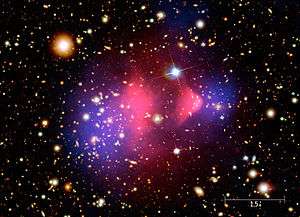Self-interacting dark matter
In astrophysics and particle physics, self-interacting dark matter (SIDM) assumes dark matter has self-interactions, in contrast to the collisionless dark matter assumed by the Lambda-CDM model. SIDM was postulated in 2000 to resolve a number of conflicts between observations and N-body simulations (of cold collisionless dark matter only) on the galactic scale and smaller.[1][2] It was also used to explain the 2015 observations of ESO 146-5 in the core of the Abell 3827 galaxy cluster.[3] However, the latter finding has since been discounted based on further observations and modelling of the cluster.[4][5]
If the self-interacting dark matter is in hydrostatic equilibrium, its pressure and density follow:
where and are the gravitational potential of the dark matter and a baryon respectively. The equation naturally correlates the dark matter distribution to that of the baryonic matter distribution. With this correlation, the self-interacting dark matter can explain phenomena such as the Tully-Fisher relation.
Self-interacting dark matter has also been postulated as an explanation for the DAMA annual modulation signal.[6][7][3]
See also
- MACS J0025.4-1222, astronomical observations that constrain DM self-interaction
- ESO 146-5, the core of Abell 3827 that was claimed as the first evidence of SIDM
- Strongly interacting massive particle (SIMP), proposed to explain cosmic ray data
References
- Spergel, David N.; Steinhardt, Paul J. (24 April 2000). "Observational evidence for self-interacting cold dark matter". Physical Review Letters. 84 (17): 3760–3763. arXiv:astro-ph/9909386. Bibcode:2000PhRvL..84.3760S. doi:10.1103/PhysRevLett.84.3760. PMID 11019199.
- Wandelt, Benjamin D.; Davé, Romeel; Farrar, Glennys R.; McGuire, Patrick C.; Spergel, David N.; Steinhardt, Paul J. (2000). Self-Interacting Dark Matter (PDF). Dark Matter. Marina del Rey. arXiv:astro-ph/0006344. Bibcode:2001sddm.symp..263W.
- Richard Massey; et al. (June 2015). "The behaviour of dark matter associated with four bright cluster galaxies in the 10 kpc core of Abell 3827". Monthly Notices of the Royal Astronomical Society. 449 (4P): 3393–3406. arXiv:1504.03388. Bibcode:2015MNRAS.449.3393M. doi:10.1093/mnras/stv467. commentary The Possible First Signs of Self-interacting Dark Matter
- Massey, Richard; et al. (August 2017), "Dark matter dynamics in Abell 3827: new data consistent with standard Cold Dark Matter", Monthly Notices of the Royal Astronomical Society, 477 (1): 669–677, arXiv:1708.04245, Bibcode:2018MNRAS.477..669M, doi:10.1093/mnras/sty630
- Grossman, Lisa (April 5, 2018), "Dark matter isn't interacting with itself after all", ScienceNews, Society for Science & the Public, retrieved 2018-04-05.
- Mitra, Saibal (15 June 2005). "Has DAMA detected self-interacting dark matter?". Physical Review D. 71 (12): 121302. arXiv:astro-ph/0409121. Bibcode:2005PhRvD..71l1302M. doi:10.1103/PhysRevD.71.121302.
- Moskowitz, Clara (20 April 2015). "Dark Matter May Feel a "Dark Force" That the Rest of the Universe Does Not". Scientific American.
Further reading
- Bertone, Gianfranco (2010). Particle Dark Matter: Observations, Models and Searches. Cambridge University Press. p. 762. Bibcode:2010pdmo.book.....B. ISBN 978-0-521-76368-4.
- Musser, George (May 2000). "What's the Matter?". Scientific American. Bibcode:2000SciAm.282e..24M. doi:10.1038/scientificamerican0500-24.
- Lawrence, Krauss (2000). Quintessence: The Search for Missing Mass in the Universe. Basic Books. p. 384. ISBN 978-0465037414.
